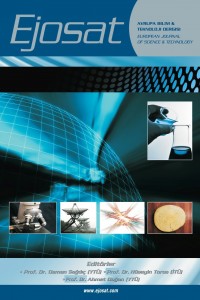Öz
The operation of wind power plants connected to the grid has been increasing rapidly in recent years. Wind power plants are attractive to use because they both relieve the network and are comparatively economical. However, wind farms are affected by the problems that may occur during their operation depending on the network. These problems are especially seen as voltage drop and increased oscillations. Dynamic modelling and control of the wind farm gains importance against these problems. Among the most important reasons for using DFIG in turbine systems are high energy yield, reduction of mechanical loads, applicability of easier angle control system, wide control of active and reactive power, and fluctuations in output power. In this study, power control results of DFIG based wind energy system by using OPAL-RT technology are given and real time control simulation is performed. Real time results have shown that when the Id current is changed in the system, active power decreases to balance the total while the reactive power increases.
Anahtar Kelimeler
DFIG based wind system OPAL-RT Power control Real time simulation
Destekleyen Kurum
Tubitak
Proje Numarası
2214 A doktora sırası araştırma
Teşekkür
This study was supported in part by The Scientific and Technological Research Council of Turkey (TUBITAK) BIDEB-2214 and the Canada Foundation for Innovation under Grant 30527.
Kaynakça
- Mirzakhani A., Ghandehari, R., Davari S. A. (2018). A new DPC-based control algorithm for improving the power quality of DFIG in unbalance grid voltage conditions. International Journal of Renewable Energy Research, 8(4).
- Tanvir A., Merabet A., Beguenane. R. ( 2015). Real-Time Control of Active and Reactive Power for Doubly Fed Induction Generator (DFIG)-Based Wind Energy Conversion System. Energies, 8, 10389-10408. doi:10.3390/en80910389
- Bakir, H., & Kulaksiz, A. A. (2020). Modelling and voltage control of the solar-wind hybrid micro-grid with optimized STATCOM using GA and BFA. Engineering Science and Technology, an International Journal, 23(3), 576-584. doi:https://doi.org/10.1016/j.jestch.2019.07.009
- Bakir, H., Merabet, A., Dhar, R. K., & Kulaksiz, A. A. (2020). Bacteria foraging optimisation algorithm based optimal control for doubly-fed induction generator wind energy system. IET Renewable Power Generation, 14(11), 1850-1859. https://digital-library.theiet.org/content/journals/10.1049/iet-rpg.2020.0172
- Drennen, T. E. (1994). Renewable Energy: Sources for Fuels and Electricity. In H. K. Thomas B. Johansson, Amulya K.N. Reddy, and Robert Williams (Ed.), Journal of Environmental Quality (Vol. 23, pp. 622-622). Washington.
- Alhajomar, F. Gokkus G., KULAKSIZ. A. A. (2019). Rapid Control Prototyping Based on 32-bit ARM Cortex-M3 Microcontroller for Photovoltaic MPPT Algorithms. International Journal of Renewable Energy Research, 9(4).
- Larsson, Å. (2000). The Power Qualities of Wind Turbines. (PhD), Chalmers University of Technology, Göteborg, Sweden.
- Merabet, A., Eshaft, H., & Tanvir, A. A. (2018). Power-current controller based sliding mode control for DFIG-wind energy conversion system. IET Renewable Power Generation, 12(10), 1155-1163. doi:10.1049/iet-rpg.2017.0313
- OPAL-RT. (2019). Powering Real-Time Simulation. Software.
Öz
Şebekeye bağlı rüzgar santrallerinin işletmesi son yıllarda hızla artmaktadır. Rüzgar enerjisi santrallerinin kullanımı caziptir çünkü hem şebekeyi rahatlatırlar hem de nispeten ekonomiktirler. Ancak rüzgar santralleri şebekeye bağlı olarak çalışmaları sırasında oluşabilecek sorunlardan etkilenmektedir. Bu sorunlar özellikle voltaj düşüşü ve artan salınımlar olarak görülmektedir. Rüzgar santralinin dinamik modellenmesi ve kontrolü bu sorunlara karşı önem kazanmaktadır. DFIG'nin rüzgar enerji sistemlerinde kullanılmasının en önemli nedenleri arasında yüksek enerji verimi, mekanik yüklerin azaltılması, daha kolay açı kontrol sisteminin uygulanabilirliği, aktif ve reaktif gücün geniş kontrolü ve çıkış gücündeki dalgalanmalar bulunmaktadır. Bu çalışmada DFIG tabanlı rüzgar enerjisi sisteminin OPAL-RT teknolojisi kullanılarak güç kontrol sonuçları verilmiş ve gerçek zamanlı kontrol simülasyonu yapılmıştır. Gerçek zamanlı sonuçlar, sistemdeki Id akımı değiştiğinde, aktif gücün reaktif güç artarken toplamı dengelemek için azaldığını göstermiştir.
Anahtar Kelimeler
DFIG tabanlı rüzgar enerji sistemi OPAL-RT Güç kontrolü Gerçek zamanlı simülasyon
Proje Numarası
2214 A doktora sırası araştırma
Kaynakça
- Mirzakhani A., Ghandehari, R., Davari S. A. (2018). A new DPC-based control algorithm for improving the power quality of DFIG in unbalance grid voltage conditions. International Journal of Renewable Energy Research, 8(4).
- Tanvir A., Merabet A., Beguenane. R. ( 2015). Real-Time Control of Active and Reactive Power for Doubly Fed Induction Generator (DFIG)-Based Wind Energy Conversion System. Energies, 8, 10389-10408. doi:10.3390/en80910389
- Bakir, H., & Kulaksiz, A. A. (2020). Modelling and voltage control of the solar-wind hybrid micro-grid with optimized STATCOM using GA and BFA. Engineering Science and Technology, an International Journal, 23(3), 576-584. doi:https://doi.org/10.1016/j.jestch.2019.07.009
- Bakir, H., Merabet, A., Dhar, R. K., & Kulaksiz, A. A. (2020). Bacteria foraging optimisation algorithm based optimal control for doubly-fed induction generator wind energy system. IET Renewable Power Generation, 14(11), 1850-1859. https://digital-library.theiet.org/content/journals/10.1049/iet-rpg.2020.0172
- Drennen, T. E. (1994). Renewable Energy: Sources for Fuels and Electricity. In H. K. Thomas B. Johansson, Amulya K.N. Reddy, and Robert Williams (Ed.), Journal of Environmental Quality (Vol. 23, pp. 622-622). Washington.
- Alhajomar, F. Gokkus G., KULAKSIZ. A. A. (2019). Rapid Control Prototyping Based on 32-bit ARM Cortex-M3 Microcontroller for Photovoltaic MPPT Algorithms. International Journal of Renewable Energy Research, 9(4).
- Larsson, Å. (2000). The Power Qualities of Wind Turbines. (PhD), Chalmers University of Technology, Göteborg, Sweden.
- Merabet, A., Eshaft, H., & Tanvir, A. A. (2018). Power-current controller based sliding mode control for DFIG-wind energy conversion system. IET Renewable Power Generation, 12(10), 1155-1163. doi:10.1049/iet-rpg.2017.0313
- OPAL-RT. (2019). Powering Real-Time Simulation. Software.
Ayrıntılar
| Birincil Dil | İngilizce |
|---|---|
| Konular | Mühendislik |
| Bölüm | Makaleler |
| Yazarlar | |
| Proje Numarası | 2214 A doktora sırası araştırma |
| Yayımlanma Tarihi | 5 Ekim 2020 |
| Yayımlandığı Sayı | Yıl 2020 Ejosat Özel Sayı 2020 (ICCEES) |


